Integrating Ecological Knowledge into Regenerative Design: A Rapid Practice Review
Abstract
:1. Introduction
2. Methods
2.1. Defining the Problem for Rapid Review
2.2. Search String and Filtering Process
2.3. Document Screening
2.4. Data Extraction and Synthesis
2.5. Quality Assessment of Selected Articles
2.6. Literature Update
2.7. Scope and Limitations
3. Articles Overview—Descriptive Results
3.1. Journal Discipline Characteristics
3.2. Spatial Scales of the ‘Built Environment’
4. Thematic Results and Discussion
4.1. Ecological Knowledge—Definitions and Types
4.1.1. ‘Scientific’ Ecological Knowledge
4.1.2. ‘Socially Constructed’ Ecological Knowledges
4.1.3. Ecological Wisdom
4.2. Built Environment Ecological Approaches
4.2.1. Urban Ecology
- ‘Ecology “in” the city’ was addressed within eight of the articles. This approach applies traditional scientific methods to gain insights on biological or biophysical elements in urban environments, often as a novel comparison to what exists beyond urban boundaries [61]. It is akin to early sustainability practice, stemming from a modernist, or ‘sanitary’, view of cities as entities isolated from the surrounding environment and reliant on technical systems to maintain function [11,47,61,66]. In this approach, human activity is seen as a disturbance to natural ecosystems [67]. Strategies that reflect this concept include: design tools that measure ecological elements [62] and community food gardens [59].
- ‘Ecology “of” the city’ was addressed within 30 of the articles. It expands on and integrates ‘Ecology “in” the city’ [63] (p. 5) by adopting a social-ecological approach that includes sustainability measures to balance energy and material flows through the built environment [61]. Scientific ecological analogies that align with this approach include urban metabolism [55], circular economy [54], and nature-based solutions [94].
- ‘Ecology “for” the city’ is informed by the previous two approaches and was addressed within 38 of the papers. This recent iteration of urban ecology ‘aims to improve the sustainability and liveability of cities through the application of urban ecological knowledge to the processes of city building in collaboration with stakeholders’ [61] (p. 965). The intention is to create ethical, mutually beneficial relationships among living systems by design. Illustrating this approach, Herrmann et al. [61] detail opportunities for partnering with communities to identify nature-based solutions that provide both ecosystem services and social amenity.
4.2.2. Ecosystem Services
4.2.3. Biophilic Design and Biophilic Urbanism
4.3. Regenerative Design—In Practice
4.3.1. Design Tools and Frameworks
4.3.2. Design Processes
4.4. Transitioning to ‘Place-Based Ecological Knowledge’
4.4.1. Enabling ‘People and Place’ Coevolution
4.4.2. Reconciling Knowledges
4.5. Updated Literature Review
5. Conclusions
Supplementary Materials
Author Contributions
Funding
Institutional Review Board Statement
Informed Consent Statement
Data Availability Statement
Acknowledgments
Conflicts of Interest
References
- World Resource Institute. Ecosystems and Human Well-Being-Synthesis: A Report of the Millennium Ecosystem Assessment; Island Press: Washington, DC, USA, 2005. [Google Scholar]
- Steffen, W.; Rockström, J.; Richardson, K.; Lenton, T.M.; Folke, C.; Liverman, D.; Summerhayes, C.P.; Barnosky, A.D.; Cornell, S.E.; Crucifix, M.; et al. Trajectories of the Earth System in the Anthropocene. Proc. Natl. Acad. Sci. USA 2018, 115, 8252–8259. [Google Scholar] [CrossRef]
- IPCC. Climate Change 2022: Impacts, Adaptation, and Vulnerability. In Contribution of Working Group II to the Sixth Assessment Report of the Intergovernmental Panel on Climate Change; Cambridge University Press: Cambridge, UK, 2022. [Google Scholar] [CrossRef]
- IPBES. Global Assessment Report on Biodiversity and Ecosystem Services of the Intergovernmental Science-Policy Platform on Biodiversity and Ecosystem Services (Version 1). Zenodo; IPBES: Bonn, Germany, 2019. [Google Scholar] [CrossRef]
- Opoku, A. Biodiversity and the built environment: Implications for the Sustainable Development Goals (SDGs). Resour. Conserv. Recycl. 2019, 141, 1–7. [Google Scholar] [CrossRef]
- Pedersen Zari, M. Ecosystem Services Analysis in Response to Biodiversity Loss Caused by the Built Environment. Surv. Perspect. Integr. Environ. Soc. 2014, p. 7. Available online: https://journals.openedition.org/sapiens/1684 (accessed on 30 August 2023).
- United Nations Human Settlements Programme. Tracking Progress towards Inclusive, Safe, Resilient and Sustainable Cities and Human Settlements. SDG11 Synthesis Report 2018; UN-Habitat: Nairobi, Kenya, 2018. [Google Scholar] [CrossRef]
- Rees, W.E. Is ‘sustainable city’ an oxymoron? Local Environ. 1997, 2, 303–310. [Google Scholar] [CrossRef]
- Rozzi, R. Biocultural Ethics: Recovering the Vital Links between the Inhabitants, Their Habits, and Habitats. Environ. Ethics 2012, 34, 27–50. [Google Scholar] [CrossRef]
- Pedersen Zari, M. Regenerative Urban Design and Ecosystem Biomimicry; Routledge: London, UK, 2018; pp. 1–68. [Google Scholar]
- Heymans, A.; Breadsell, J.; Morrison, G.M.; Byrne, J.J.; Eon, C. Ecological urban planning and design: A systematic literature review. Sustainability 2019, 11, 3723. [Google Scholar] [CrossRef]
- Blanco, E.; Raskin, K.; Clergeau, P. Reconnecting neighbourhoods with ecosystem functioning: Analysis of solutions from six international case studies. Sustain. Cities Soc. 2022, 77, 103558. [Google Scholar] [CrossRef]
- Mouritz, L.; Breedon, A. Country-Led Approaches in Land Management and Design. Archit. Des. 2022, 92, 96–103. [Google Scholar] [CrossRef]
- Hes, D.; Du Plessis, C. Designing for Hope: Pathways to Regenerative Sustainability; Routledge: Oxfordshire, UK, 2015. [Google Scholar]
- Reed, B. Shifting from ‘sustainability’ to regeneration. Build. Res. Inf. 2007, 35, 674–680. [Google Scholar] [CrossRef]
- Lawrence, R.J. Overcoming Barriers to Implementing Sustainable Development Goals: Human Ecology Matters. Hum. Ecol. Rev. 2020, 26, 95–116. [Google Scholar] [CrossRef]
- Baumeister, D.; Tocke, R.; Dwyer, J.; Ritter, S.; Benyus, J. Biomimicry Resource Handbook: A Seed Bank of Knowledge and Best Practices; Biomimicry 3.8: Missoula, MT, USA, 2013. [Google Scholar]
- Benyus, J.M. A Biomimicry Primer. 2011. Available online: https://asknature.org/resource/a-biomimicry-primer/ (accessed on 31 July 2023).
- United Nations Human Settlements Programme (UN-Habitat). World Cities Report 2022: Envisaging the Future of Cities; UN-Habitat: Nairobi, Kenya, 2022; Available online: https://unhabitat.org/sites/default/files/2022/06/wcr_2022.pdf (accessed on 30 August 2023).
- United Nations. Transforming Our World: The 2030 Agenda for Sustainable Development; United Nations: New York, NY, USA, 2015; Available online: https://sdgs.un.org/publications/transforming-our-world-2030-agenda-sustainable-development-17981 (accessed on 30 August 2023).
- Royal Danish Academy; UIA. Architecture Guide to the UN 17 Sustainable Development Goals. 2018. Available online: https://www.uia-architectes.org/wp-content/uploads/2022/03/sdg_commission_un17_guidebook.pdf (accessed on 31 August 2023).
- Royal Danish Academy; UIA. An Architecture Guide to the UN 17 Sustainable Development Goals. 2020, Volume 2. Available online: https://www.uia-architectes.org/en/resource/architecture-guide-sdg-vol-2/ (accessed on 31 August 2023).
- Secretariat of the Convention on Biological Diversity. Cities and Biodiversity Outlook; Montreal, Quebec, Canada. 2012. Available online: https://wedocs.unep.org/20.500.11822/32431 (accessed on 30 August 2023).
- Steiner, F. The Wisdom of Looking Forward Through Ecological Design and Planning. In Ecological Wisdom: Theory and Practice; Yang, B., Young, R.F., Eds.; EcoWISE-Innovative Approaches to Socio-Ecological Sustainability; Springer: Singapore, 2019; pp. 151–173. [Google Scholar]
- Benne, B.; Mang, P. Working regeneratively across scales—Insights from nature applied to the built environment. J. Clean. Prod. 2015, 109, 42–52. [Google Scholar] [CrossRef]
- Camrass, K. Regenerative futures. Foresight 2020, 22, 410–415. [Google Scholar] [CrossRef]
- Du Plessis, C. The City Sustainable, Resilient, Regenerative–A Rose by Any Other Name. In Design for Regenerative Cities and Landscapes; Springer International: Cham, Switzerland, 2022; pp. 23–48. [Google Scholar] [CrossRef]
- Gibbons, L.V. Regenerative—The new sustainable? Sustainability 2020, 12, 5483. [Google Scholar] [CrossRef]
- Gibbons, L.V.; Pearthree, G.; Cloutier, S.A.; Ehlenz, M.M. The development, application, and refinement of a Regenerative Development Evaluation Tool and indicators. Ecol. Indic. 2020, 108, 105698. [Google Scholar] [CrossRef]
- Mang, P.; Reed, B. Designing from place: A regenerative framework and methodology. Build. Res. Inf. 2012, 40, 23–38. [Google Scholar] [CrossRef]
- Roös, P.B. Regenerative Design, Ecology as Teacher. In Regenerative-Adaptive Design for Sustainable Development; Springer: Cham, Switzerland, 2021; pp. 103–112. [Google Scholar] [CrossRef]
- Benyus, J.; Dwyer, J.; El-Sayed, S.; Hayes, S.; Baumeister, D.; Penick, C.A. Ecological performance standards for regenerative urban design. Sustain. Sci. 2022, 17, 2631–2641. [Google Scholar] [CrossRef]
- Cole, R.J. Transitioning from green to regenerative design. Build. Res. Inf. 2012, 40, 39–53. [Google Scholar] [CrossRef]
- Mang, P.; Reed, B. Regenerative Development and Design. In Sustainable Built Environments; Springer: Berlin, Germany, 2020; pp. 115–141. [Google Scholar] [CrossRef]
- Tricco, A.; Langlois, E.; Straus, S. (Eds.) Rapid Reviews to Strengthen Health Policy and Systems: A Practical Guide; World Health Organization: Geneva, Switzerland, 2017; ISBN 9789241512763. Available online: https://apps.who.int/iris/bitstream/handle/10665/258698/9789241512763-eng.pdf?sequence=1&isAllowed=y (accessed on 30 August 2023).
- Eon, C.; Breadsell, J.K.; Byrne, J.; Morrison, G.M. The Discrepancy between As-Built and As-Designed in Energy Efficient Buildings: A Rapid Review. Sustainability 2020, 12, 6372. [Google Scholar] [CrossRef]
- Lagisz, M.; Samarasinghe, G.; Nakagawa, S. Rapid Reviews for the Built Environment-Methodology and Guidelines; Low Carbon Living CRC (CRCLCL): Sydney, Australia, 2018; p. 22. Available online: https://apo.org.au/sites/default/files/resource-files/2019-05/apo-nid236366.pdf (accessed on 30 August 2023).
- Lagisz, M.; Samarasinghe, G.; Nakagawa, S.; Upadhyay, A.K.; De La Peña Suarez, F.; Twomey, P. Do Green-Rated Office Buildings Save Operational Energy? CRCLCL: Sydney, Australia, 2018. [Google Scholar] [CrossRef]
- Sinclair, S.; Rockwell, G. Voyant Tools. Available online: http://voyant-tools.org/ (accessed on 23 April 2023).
- Lemon, L.L.; Hayes, J. Enhancing Trustworthiness of Qualitative Findings: Using Leximancer for Qualitative Data Analysis Triangulation. Qual. Rep. 2020, 25, 604–614. [Google Scholar] [CrossRef]
- Blanco, E.; Raskin, K.; Clergeau, P. Towards regenerative neighbourhoods: An international survey on urban strategies promoting the production of ecosystem services. Sustain. Cities Soc. 2022, 80, 103784. [Google Scholar] [CrossRef]
- Zingoni de Baro, M.E.; Macedo, J. The role of regenerative design and Biophilic urbanism in regional sustainability. The case of Curitiba. In Bioregional Planning and Design: Volume II; Fanfani, D., Mataran Ruiz, A., Eds.; Springer: Cham, Switzerland, 2020; Volume II, pp. 225–241. [Google Scholar] [CrossRef]
- Crowley, D.; Marat-Mendes, T.; Falanga, R.; Henfrey, T.; Penha-Lopes, G. Towards a necessary regenerative urban planning. Insights from community-led initiatives for ecocity transformation. Cidades. Comunidades Territ. 2021, Sp21, 83–104. [Google Scholar] [CrossRef]
- Pickett, S.T.A.; McGrath, B.; Cadenasso, M.L.; Felson, A.J. Ecological resilience and resilient cities. Build. Res. Inf. 2014, 42, 143–157. [Google Scholar] [CrossRef]
- Young, R.F.; Lieberknecht, K. From smart cities to wise cities: Ecological wisdom as a basis for sustainable urban development. J. Environ. Plan. Manag. 2019, 62, 1675–1692. [Google Scholar] [CrossRef]
- Pedersen Zari, M. Biomimetic urban and architectural design: Illustrating and leveraging relationships between ecosystem services. Biomimetics 2021, 6, 2. [Google Scholar] [CrossRef] [PubMed]
- Pincetl, S. Nature, urban development and sustainability—What new elements are needed for a more comprehensive understanding? Cities 2012, 29, S32–S37. [Google Scholar] [CrossRef]
- Tan, P.Y.; Abdul Hamid, A.R.B. Urban ecological research in Singapore and its relevance to the advancement of urban ecology and sustainability. Landsc. Urban Plan. 2014, 125, 271–289. [Google Scholar] [CrossRef]
- Blanco, E.; Pedersen Zari, M.; Raskin, K.; Clergeau, P. Urban ecosystem-level biomimicry and regenerative design: Linking ecosystem functioning and urban built environments. Sustainability 2021, 13, 404. [Google Scholar] [CrossRef]
- Du Plessis, C. Understanding cities as social-ecological systems. In Proceedings of the World Sustainable Building Conference, Melbourne, Australia, 21–25 September 2008. [Google Scholar]
- Pedersen Zari, M. Ecosystem services analysis for the design of regenerative built environments. Build. Res. Inf. 2012, 40, 54–64. [Google Scholar] [CrossRef]
- Pedersen Zari, M. Ecosystem services analysis: Mimicking ecosystem services for regenerative urban design. Int. J. Sustain. Built Environ. 2015, 4, 145–157. [Google Scholar] [CrossRef]
- Pedersen Zari, M.; Hecht, K. Biomimicry for regenerative built environments: Mapping design strategies for producing ecosystem services. Biomimetics 2020, 5, 18. [Google Scholar] [CrossRef]
- Casazza, M.; Liu, G.; Maglioccola, F.; Lega, M. A retrospective comparison on europe and china ecological wisdom of pre-industrial urban communities under the lens of sustainability pillars. J. Environ. Account. Manag. 2020, 8, 365–385. [Google Scholar] [CrossRef]
- Clementi, M.; Fontana, C. The systemic approach in sustainable environmental planning: References to the ecology of living systems. Techne 2019, 17, 143–151. [Google Scholar] [CrossRef]
- Felson, A.J.; Pavao-Zuckerman, M.; Carter, T.; Montalto, F.; Shuster, B.; Springer, N.; Stander, E.K.; Starry, O. Mapping the Design Process for Urban Ecology Researchers. BioScience 2013, 63, 854–865. [Google Scholar] [CrossRef]
- Zingoni de Baro, M.E. Two Social-Ecological Design Approaches to Regenerative Sustainability. In Regenerating Cities; Cities and Nature; Springer: Cham, Switzerland, 2022; pp. 61–96. [Google Scholar] [CrossRef]
- Pedersen Zari, M. Chapters 1–3: “A shift in architectural and urban design: Cities as a medium of change”, “Incorporating biomimicry into regenerative design” and “Can built environment biomimicry address climate change?”. In Regenerative Urban Design and Ecosystem Biomimicry; Taylor and Francis: Abingdon, UK, 2018; pp. 1–68. [Google Scholar] [CrossRef]
- Barthel, S.; Folke, C.; Colding, J. Social–ecological memory in urban gardens: Retaining capacity for management of ecosystem services. Glob. Environ. Change 2010, 20, 255–265. [Google Scholar] [CrossRef]
- Gibbons, L.V.; Cloutier, S.A.; Coseo, P.J.; Barakat, A. Regenerative development as an integrative paradigm and methodology for landscape sustainability. Sustainability 2018, 10, 1910. [Google Scholar] [CrossRef]
- Herrmann, D.L.; Schwarz, K.; Shuster, W.D.; Berland, A.; Chaffin, B.C.; Garmestani, A.S.; Hopton, M.E. Ecology for the Shrinking City. Bioscience 2016, 66, 965. [Google Scholar] [CrossRef] [PubMed]
- Parivar, P.; Quanrud, D.; Sotoudeh, A.; Abolhasani, M. Evaluation of urban ecological sustainability in arid lands (Case Study: Yazd-Iran). Environ. Dev. Sustain. 2021, 23, 2797–2826. [Google Scholar] [CrossRef]
- Pickett, S.T.A.; Cadenasso, M.L.; Childers, D.L.; McDonnell, M.J.; Zhou, W. Evolution and future of urban ecological science: Ecology in, of, and for the city. Ecosyst. Health Sustain. 2016, 2, e01229. [Google Scholar] [CrossRef]
- Schwann, A. Ecological wisdom: Reclaiming the cultural landscape of the Okanagan Valley. J. Urban Manag. 2018, 7, 172–180. [Google Scholar] [CrossRef]
- Xiang, W.-N. Ecophronesis: The ecological practical wisdom for and from ecological practice. Landsc. Urban Plan. 2016, 155, 53–60. [Google Scholar] [CrossRef]
- Young, R.F. Modernity, postmodernity, and ecological wisdom: Toward a new framework for landscape and urban planning. Landsc. Urban Plan. 2016, 155, 91–99. [Google Scholar] [CrossRef]
- Tomalty, R. The ecology of cities. Altern. J. 2009, 35, 19–21. [Google Scholar]
- Ou, M.; Lai, X.; Gong, J. Territorial Pattern Evolution and Its Comprehensive Carrying Capacity Evaluation in the Coastal Area of Beibu Gulf, China. Int. J. Environ. Res. Public Health 2022, 19, 10469. [Google Scholar] [CrossRef] [PubMed]
- Wang, X.; Kumari, D. A Socio-Ecological Perspective on Green Urbanisation and Urban Ecological Intensification. In Building Materials for Sustainable and Ecological Environment; Achal, V., Chin, C.S., Eds.; Springer: Singapore, 2021; pp. 163–172. [Google Scholar] [CrossRef]
- Wu, Q.; Cao, Y.; Fang, X.; Wang, J.; Li, G. A systematic coupling analysis framework and multi-stage interaction mechanism between urban land use efficiency and ecological carrying capacity. Sci. Total Environ. 2022, 853, 158444. [Google Scholar] [CrossRef] [PubMed]
- Berkes, F.; Colding, J.; Folke, C. Rediscovery of traditional ecological knowledge as adaptive management. Ecol. Appl. 2000, 10, 1251–1262. [Google Scholar] [CrossRef]
- Camrass, K. Regenerative urbanism: A causal layered analysis. Foresight 2023, 25, 4. [Google Scholar] [CrossRef]
- Cole, R.J.; Busby, P.; Guenther, R.; Briney, L.; Blaviesciunaite, A.; Alencar, T. A regenerative design framework: Setting new aspirations and initiating new discussions. Build. Res. Inf. 2012, 40, 95–111. [Google Scholar] [CrossRef]
- Du Plessis, C. Towards a regenerative paradigm for the built environment. Build. Res. Inf. 2012, 40, 7–22. [Google Scholar] [CrossRef]
- Du Plessis, C.; Brandon, P. An ecological worldview as basis for a regenerative sustainability paradigm for the built environment. J. Clean. Prod. 2015, 109, 53–61. [Google Scholar] [CrossRef]
- Hes, D.; Stephan, A.; Moosavi, S. Putting Regenerative Development into Action: Understanding the Decision Making Process of a 680 Hectare Regenerative Project. In Proceedings of the World Sustainable Built Environment Conference, Hong Kong, 5–7 June 2017. [Google Scholar]
- Koat, J.; Zari, M.P. Biodiver_Cities: An exploration of how architecture and urban design can regenerate ecosystem services. In Proceedings of the 53rd International Conference of the Architectural Science Association, Roorkee, India, 28–30 November 2019; pp. 115–124. [Google Scholar]
- Zingoni de Baro, M.E. An Integrated Framework for Designing Regenerative Sustainable Urban Environments. In Regenerating Cities; Cities and Nature; Springer: Cham, Switzerland, 2022; pp. 97–116. [Google Scholar]
- Pedersen Zari, M. Biomimetic design for climate change adaptation and mitigation. Archit. Sci. Rev. 2010, 53, 172–183. [Google Scholar] [CrossRef]
- Craft, W.; Ding, L.; Prasad, D. Developing a decision-making framework for regenerative precinct development. Sustainability 2021, 13, 12604. [Google Scholar] [CrossRef]
- Marshall, C.; Twill, J. Using Indigenous Knowledge in Climate Resistance Strategies for Future Urban Environments. In Design for Regenerative Cities and Landscape; Roggema, R., Ed.; Springer Nature: Cham, Switzerland, 2022; pp. 49–63. [Google Scholar]
- Tutor, L. Design process of a water reclamation garden: From natural niches to urban environment. In Proceedings of the World Sustainable Built Environment—Beyond 2020, Gothenberg, Sweden, 2–4 November 2020. [Google Scholar]
- Camrass, K. Urban regenerative thinking and practice: A systematic literature review. Build. Res. Inf. 2022, 50, 339–350. [Google Scholar] [CrossRef]
- Craft, W.; Ding, L.; Prasad, D. Understanding decision-making in regenerative precinct developments. J. Clean. Prod. 2022, 338, 130672. [Google Scholar] [CrossRef]
- Plaut, J.; Dunbar, B.; Gotthelf, H.; Hes, D. Regenerative development through LENSES with a case study of Seacombe West. Environ. Des. Guide 2016, EDG 88JP, 1–19. Available online: https://www.jstor.org/stable/10.2307/26152198 (accessed on 30 August 2023).
- Plaut, J.M.; Dunbar, B.; Wackerman, A.; Hodgin, S. Regenerative design: The LENSES Framework for buildings and communities. Build. Res. Inf. 2012, 40, 112–122. [Google Scholar] [CrossRef]
- Hindley, J. A park for the 21st century: Observations on the transformation of mile end park. Capital. Nat. Social. 2007, 18, 104–124. [Google Scholar] [CrossRef]
- Gibbons, L.V. Moving beyond sustainability: A Regenerative Community Development Framework for co-creating thriving living systems and its application. J. Sustain. Dev. 2020, 13, 20–52. [Google Scholar] [CrossRef]
- Hes, D.; Stephan, A.; Moosavi, S. Evaluating the practice and outcomes of applying regenerative development to a large-scale project in Victoria, Australia. Sustainability 2018, 10, 460. [Google Scholar] [CrossRef]
- Pedersen Zari, M. An architectural love of the living: Bio-inspired design in the pursuit of ecological regeneration and psychological wellbeing. WIT Trans. Ecol. Environ. 2009, 120, 293–302. [Google Scholar] [CrossRef]
- Pedersen Zari, M. Regenerative design for the future. Build 2010, 115, 68–69. [Google Scholar]
- Pedersen Zari, M.; Jenkin, S. Re-defining cutting edge sustainable design: From eco-efficiency to regenerative development. In Proceedings of the Sustainable Building Conference (SB10), Wellington, New Zealand, 26–28 May 2010. [Google Scholar]
- Robinson, J.; Cole, R.J. Theoretical underpinnings of regenerative sustainability. Build. Res. Inf. 2015, 43, 133–143. [Google Scholar] [CrossRef]
- Van der Jagt, A.P.N.; Smith, M.; Ambrose-Oji, B.; Konijnendijk, C.C.; Giannico, V.; Haase, D.; Lafortezza, R.; Nastran, M.; Pintar, M.; Železnikar, Š.; et al. Co-creating urban green infrastructure connecting people and nature: A guiding framework and approach. J. Environ. Manag. 2019, 233, 757–767. [Google Scholar] [CrossRef] [PubMed]
- Wahl, D.C. Scale-linking design for systemic health: Sustainable communities and cities in context. Int. J. Ecodyn. 2007, 2, 57–72. [Google Scholar] [CrossRef]
- Suryantini, R.; Harahap, M.M.Y.; Yatmo, Y.A.; Putra, N. Thinking ecology for architecture: Exploration of cool pockets. In Proceedings of the 3rd International Tropical Renewable Energy Conference “Sustainable Development of Tropical Renewable Energy”, Bali, Indonesia, 6–8 September 2018. [Google Scholar]
- Zhao, Z.; Zhang, S.; Peng, Y. Analysis of Winter Environment Based on CFD Simulation: A Case Study of Feng Shui Layout. Buildings 2023, 13, 1101. [Google Scholar] [CrossRef]
- Othmani, N.I.; Mohamed, S.A.; Abdul Hamid, N.H.; Ramlee, N.; Yeo, L.B.; Mohd Yunos, M.Y. Reviewing biomimicry design case studies as a solution to sustainable design. Environ. Sci. Pollut. Res. 2022, 29, 69327–69340. [Google Scholar] [CrossRef]
- Pedersen Zari, M. Biomimetic approaches to architectural design for increased sustainability. In Proceedings of the SB07 NZ Sustainable Building Conference, Auckland, New Zealand, 14–16 November 2007. [Google Scholar]
- Al-Obaidi, T.; Prior, J.; McIntyre, E. Conceptual Approaches of Health and Wellbeing at the Apartment Building Scale: A Review of Australian Studies. Sustainability 2022, 14, 15536. [Google Scholar] [CrossRef]
- Cole, R.J.; Oliver, A.; Robinson, J. Regenerative design, socio-ecological systems and co-evolution. Build. Res. Inf. 2013, 41, 237–247. [Google Scholar] [CrossRef]
- Svec, P.; Berkebile, R.; Todd, J.A. REGEN: Toward a tool for regenerative thinking. Build. Res. Inf. 2012, 40, 81–94. [Google Scholar] [CrossRef]
- Mang, P.; Reed, B. The nature of positive. Build. Res. Inf. 2015, 43, 7–10. [Google Scholar] [CrossRef]
- Fu, X.; Wang, X.H.; Schock, C.; Stuckert, T. Ecological wisdom as benchmark in planning and design. Landsc. Urban Plan. 2016, 155, 79–90. [Google Scholar] [CrossRef]
- Yates, A.; Zari, M.P.; Bloomfield, S.; Burgess, A.; Walker, C.; Waghorn, K.; Besen, P.; Sargent, N.; Palmer, F. A Transformative Architectural Pedagogy and Tool for a Time of Converging Crises. Urban Sci. 2023, 7, 1. [Google Scholar] [CrossRef]
- Kellert, S.R.; Wilson, E.O. The Biophilia Hypothesis; Island Press: Washington, DC, USA, 1994; p. 484. [Google Scholar]
- Pilgrim, S.E.; Cullen, L.C.; Smith, D.J.; Pretty, J. Ecological Knowledge is Lost in Wealthier Communities and Countries. Environ. Sci. Technol. 2007, 42, 1004–1009. [Google Scholar] [CrossRef] [PubMed]
- Poelina, A.; Wooltorton, S.; Blaise, M.; Aniere, C.L.; Horwitz, P.; White, P.J.; Muecke, S. Regeneration time: Ancient wisdom for planetary wellbeing. Aust. J. Environ. Educ. 2022, 38, 397–414. [Google Scholar] [CrossRef]
- Wheeler, S.M. Sustainability planning as paradigm change. Urban Plan. 2016, 1, 55–58. [Google Scholar] [CrossRef]
- Biomimicry Institute. Designing Society through the Natural World: 4 Questions with Janine Benyus at the Aspen Ideas Festival. 2018. Available online: https://biomimicry.medium.com/4-questions-with-janine-benyus-at-the-aspen-ideas-festival-747e8da49e10 (accessed on 28 May 2023).
- Pedersen Zari, M.; Storey, J. An ecosystem based biomimetic theory for a regenerative built environment. In Proceedings of the Sustainable Building Conference (SB07), Lisbon, Portugal, 12–14 September 2007. [Google Scholar]
- Orr, D.W. Earth in Mind: On Education, Environment and the Human Prospect; Island Press: Washington, DC, USA, 2004. [Google Scholar]
- Liao, K.-H.; Chan, J.K.H. What is ecological wisdom and how does it relate to ecological knowledge? Landsc. Urban Plan. 2016, 155, 111–113. [Google Scholar] [CrossRef]
- Hoxie, C.; Berkebile, R.; Todd, J.A. Stimulating regenerative development through community dialogue. Build. Res. Inf. 2012, 40, 65–80. [Google Scholar] [CrossRef]
- Benyus, J. Biomimicry: Innovation Inspired by Nature; Harper Collins: New York, NY, USA, 2002. [Google Scholar]
- Wooltorton, S.; Guenther, J.; Poelina, A.; Blaise, M.; Collard, L.; White, P. Learning regenerative cultures: Indigenous nations in higher education renewal in Australia. Asia Pac. Educ. Rev. 2022, 23, 639–651. [Google Scholar] [CrossRef]
- Li, W.-T.; Shein, P.P. Developing sense of place through a place-based Indigenous education for sustainable development curriculum. Environ. Educ. Res. 2023, 29, 692–714. [Google Scholar] [CrossRef]
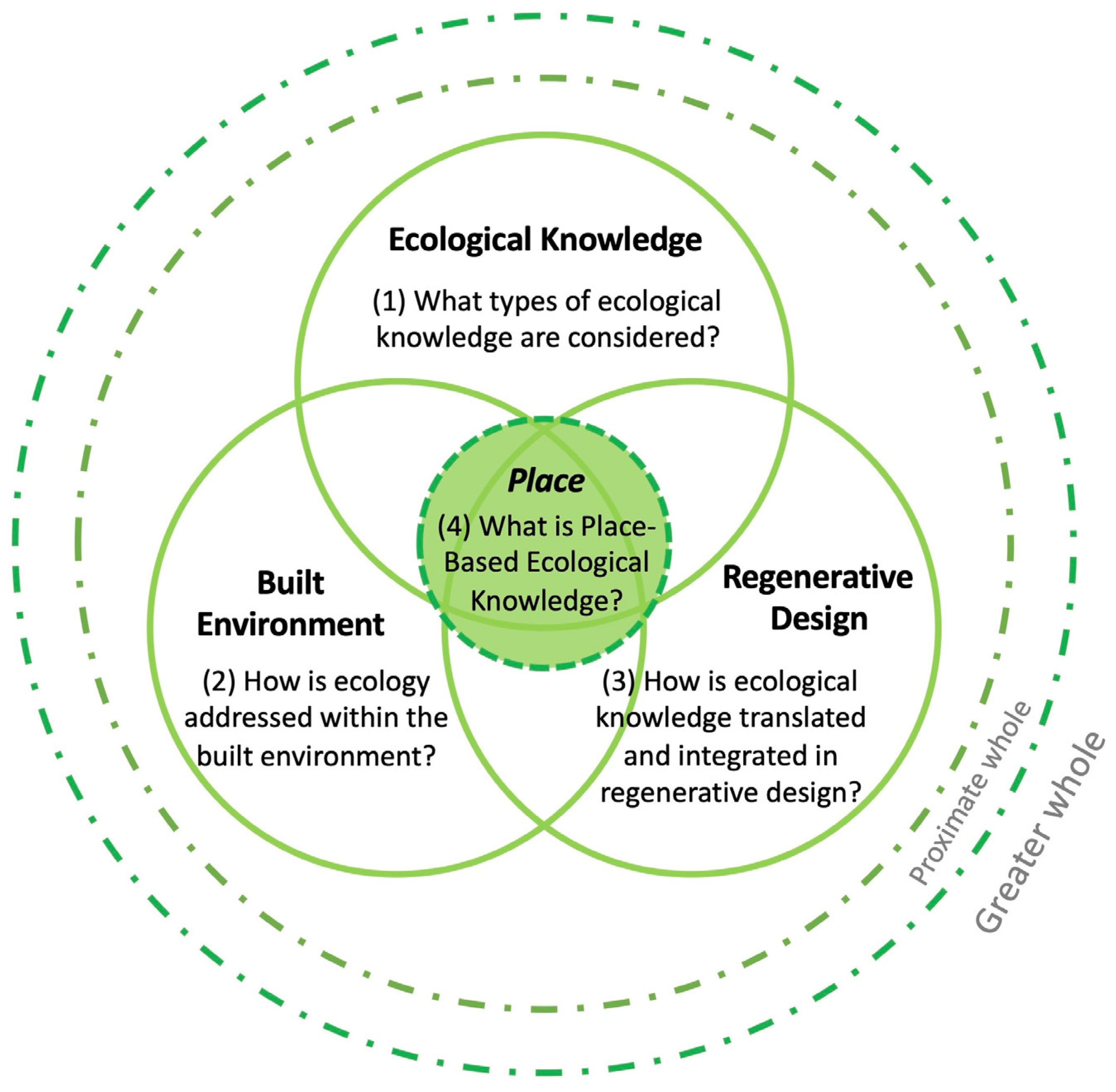
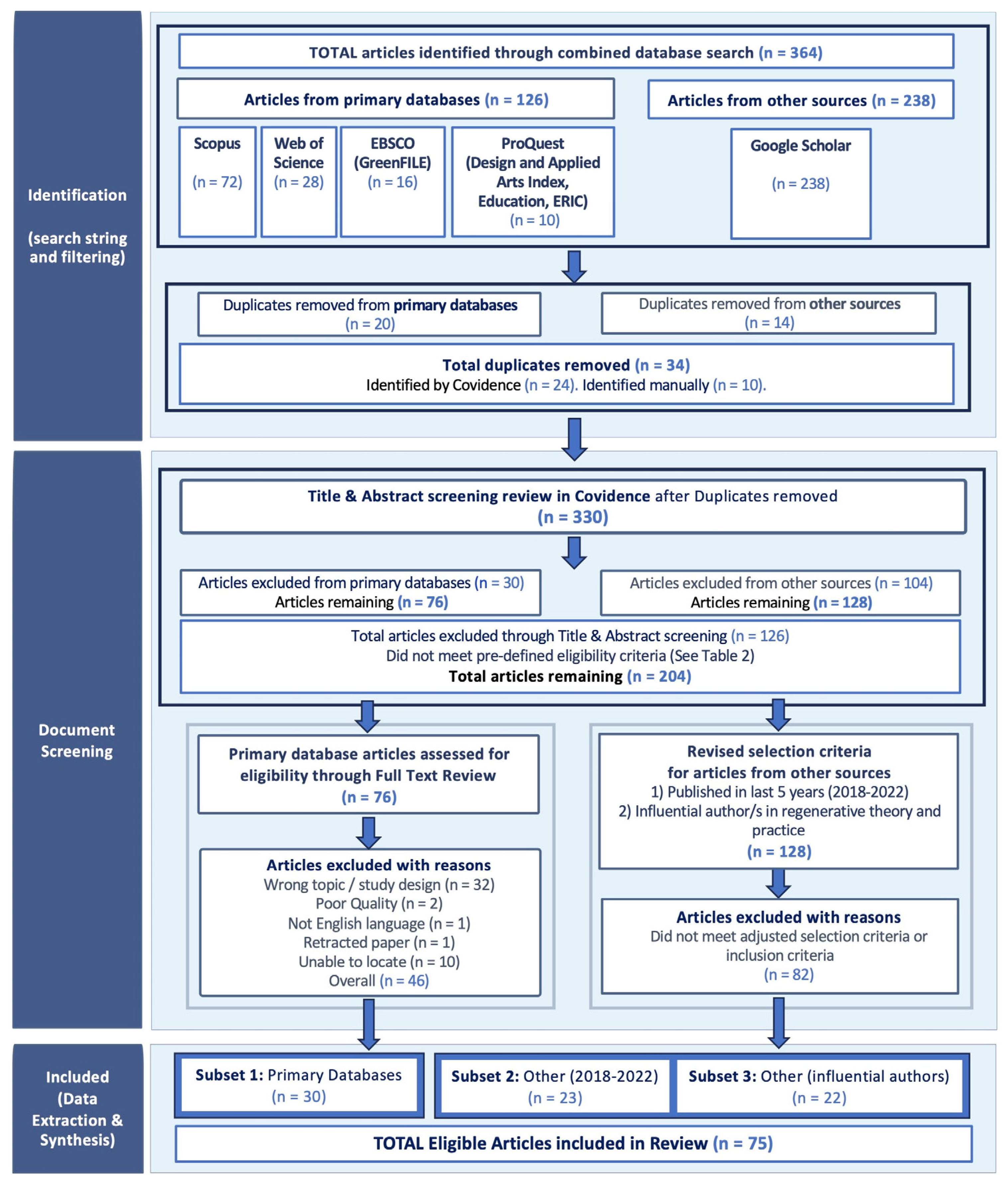
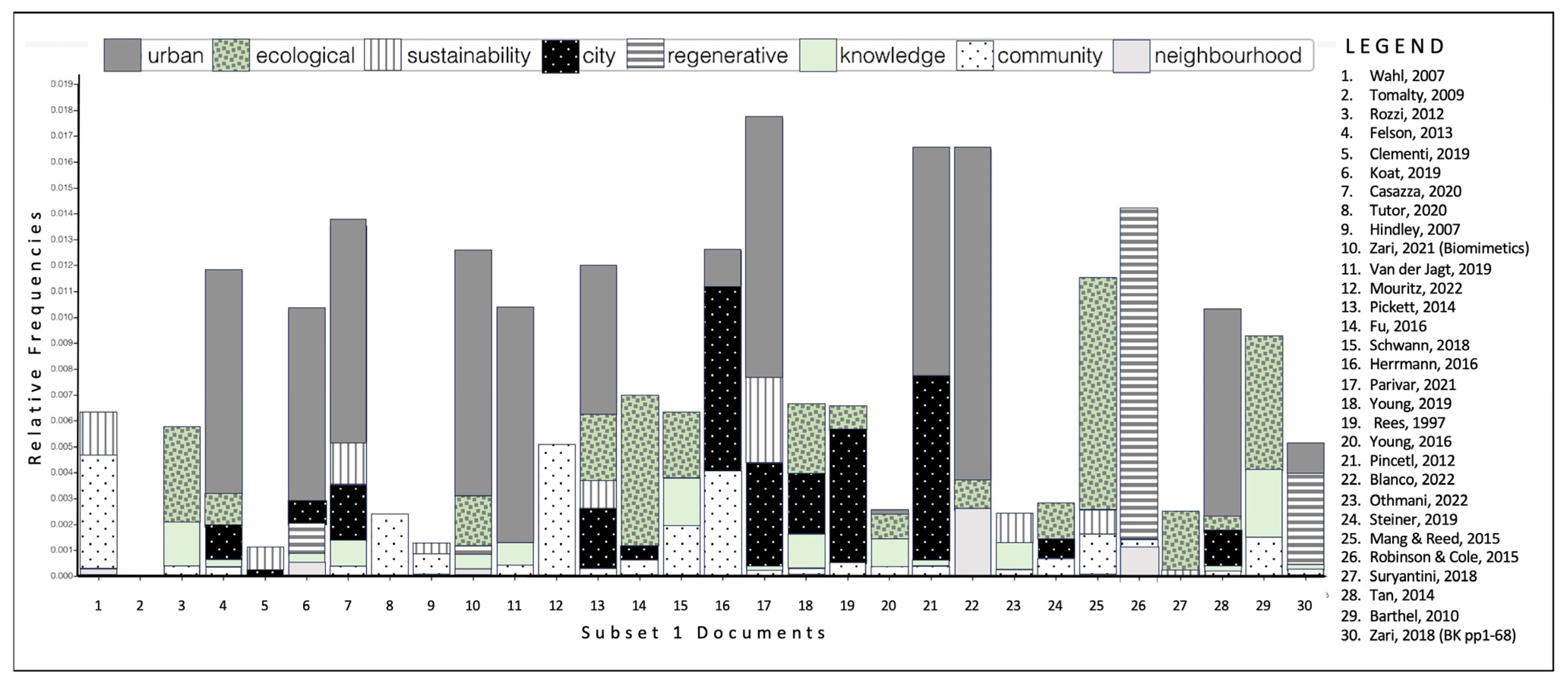
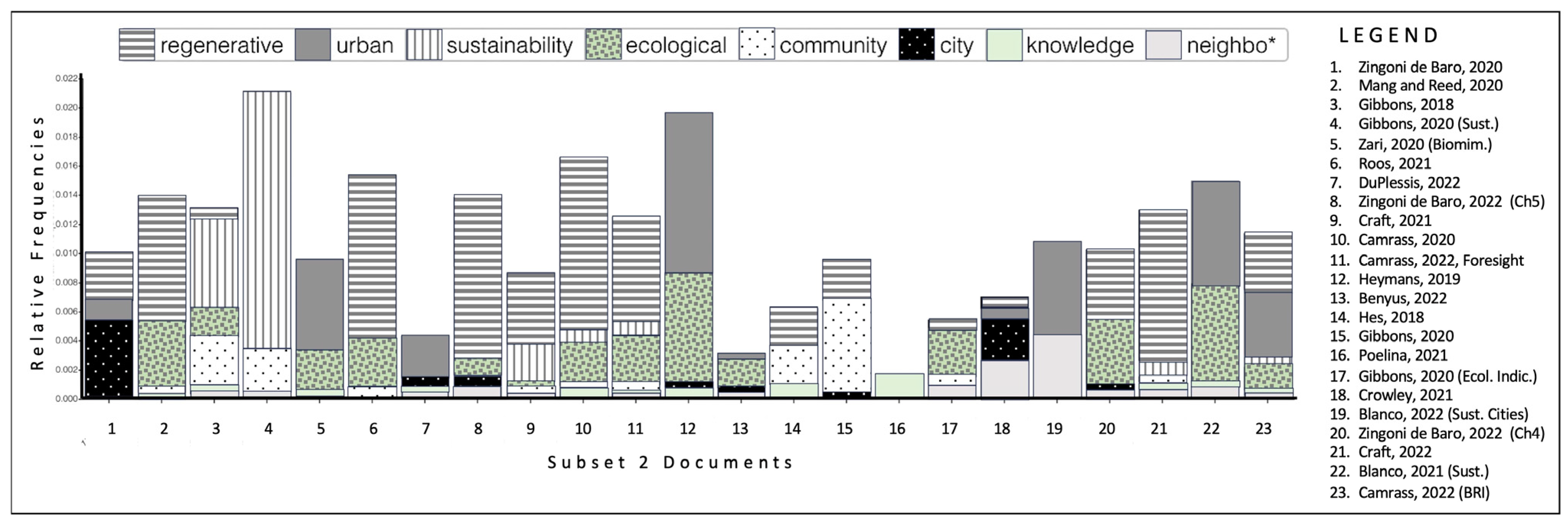
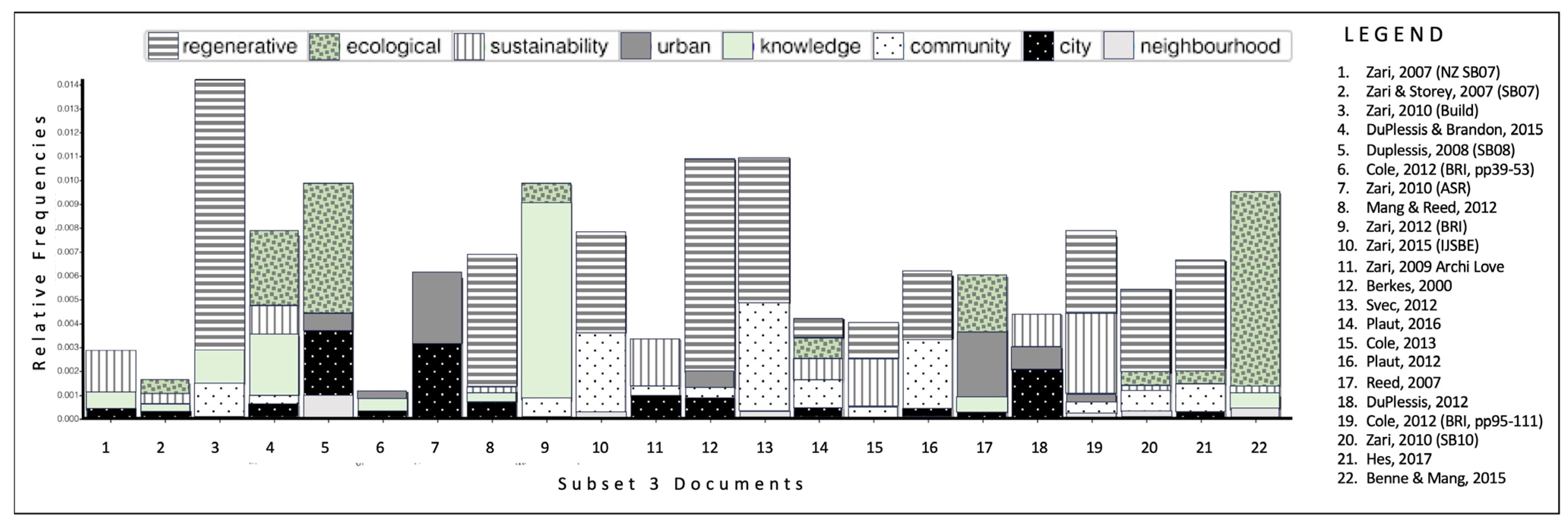
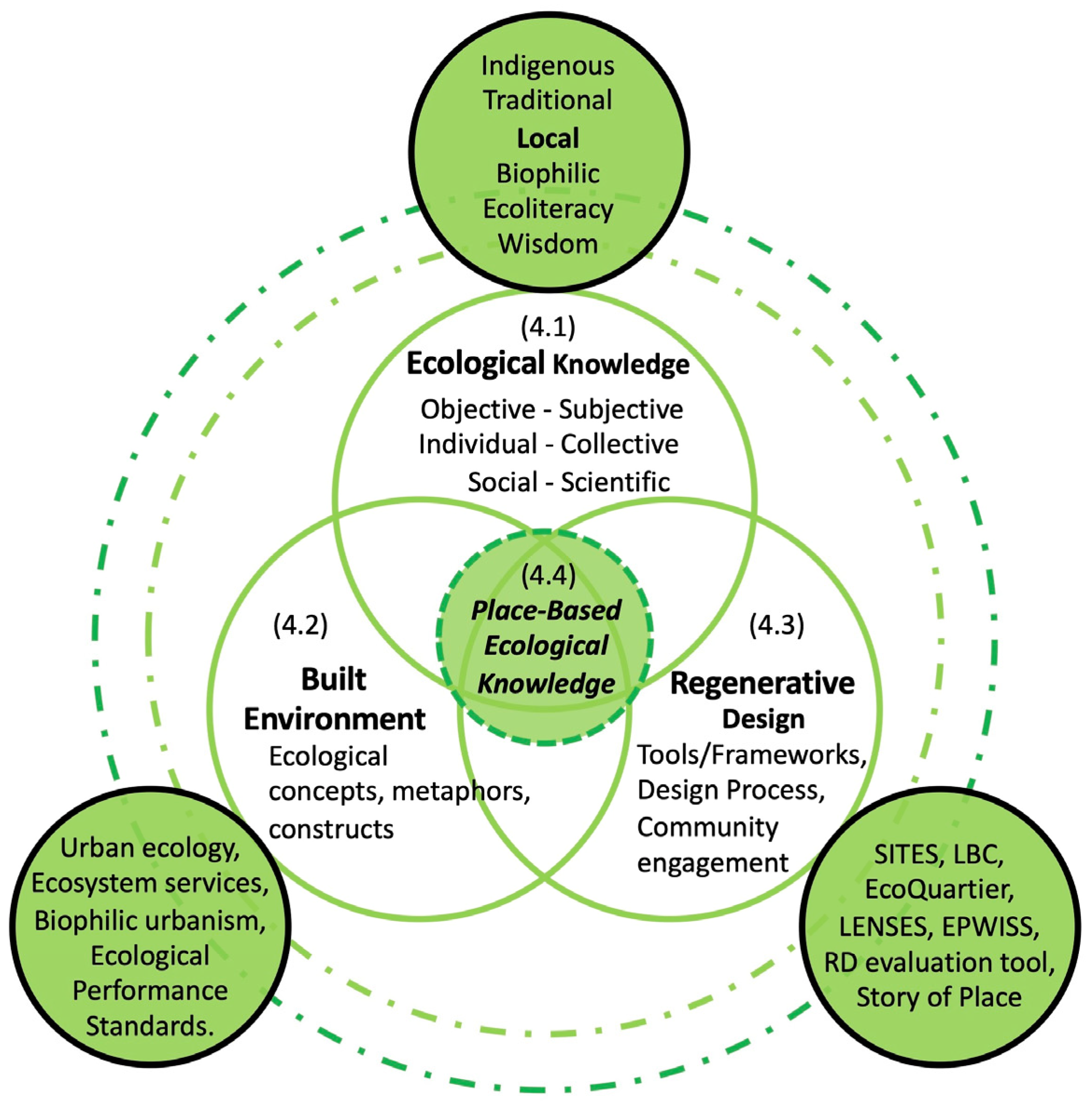
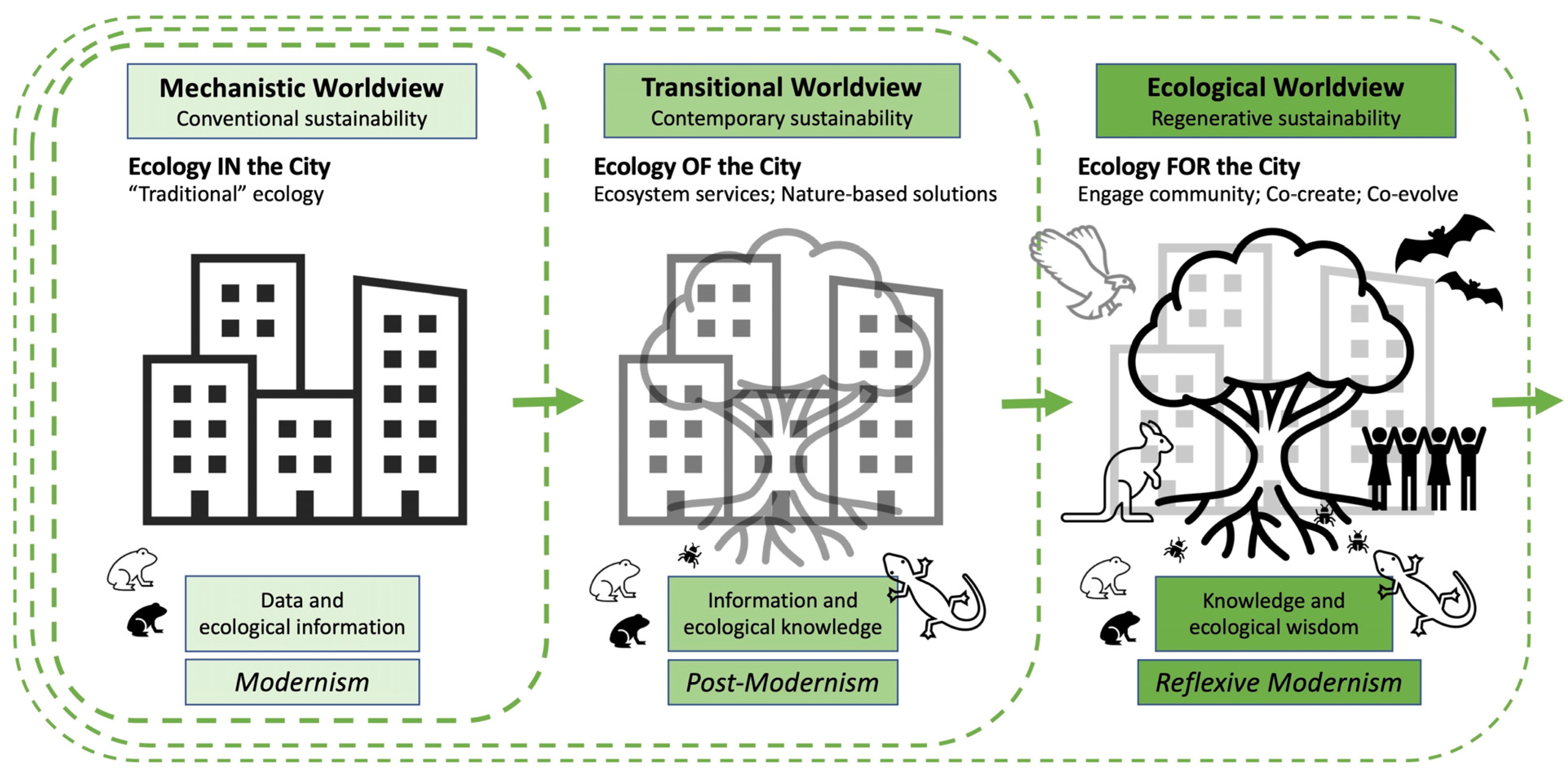
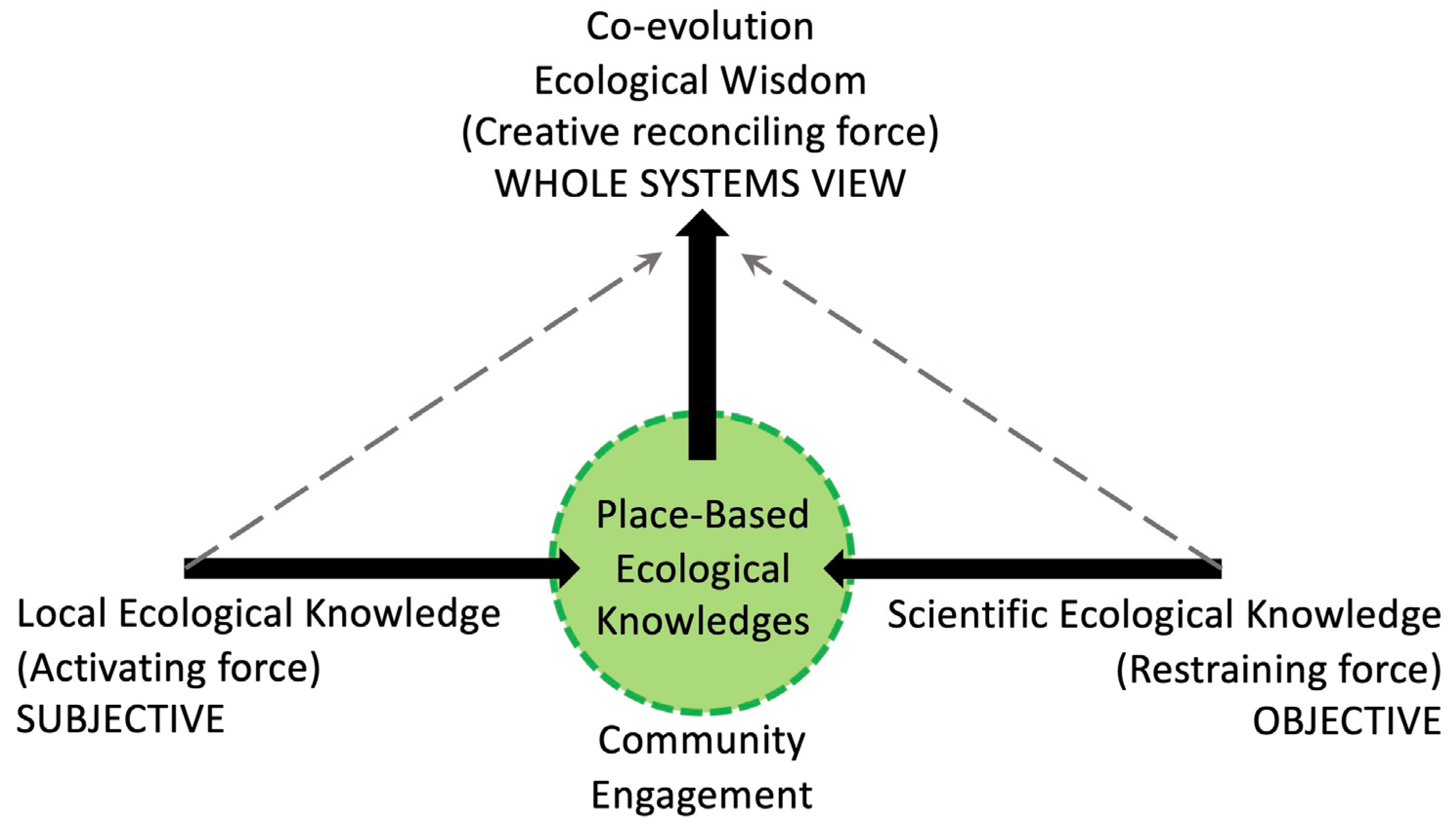
| Key Terms | Regenerative~ OR Sustainable~ | Ecological Knowledge | Built Environment |
|---|---|---|---|
| Search string terms | Design Development Practice Architecture Thinking Place | Ecoliteracy Eco-literacy Ecological~ Knowledge Understanding Awareness Wisdom Literacy | Urban environment Urban planning Site planning Site analysis |
| Inclusion Criteria | Exclusion Criteria |
|---|---|
|
|
| Database | No. of Articles | No. of Articles After Title and Abstract Review | No. of Articles After Full Text Review |
|---|---|---|---|
| EBSCO—GreenFile | 1 | 1 | 1 |
| Web of Science | 2 | 2 | 2 |
| Scopus | 12 | 5 * | 5 |
| ProQuest | 0 | 0 | 0 |
| Google Scholar | 0 | 0 | 0 |
| TOTAL | 15 | 8 | 8 |
| Journal Discipline Categories 1 | Subset 1— Primary Database Articles | Subset 2— GS Articles (2018–2022) | Subset 3— GS Articles Expert | Total No. | Total % |
|---|---|---|---|---|---|
| Built Environment Sector | 9 | 2 | 11 | 22 | 29.3 |
| Sustainability | 2 | 9 | 1 | 12 | 16.0 |
| Ecology, Biology, Enviro. | 5 | 2 | 2 | 9 | 12.0 |
| Environmental Management | 4 | 3 | 3 | 10 | 13.3 |
| Social Issues | 5 | 1 | 0 | 6 | 8.0 |
| Book Chapters | 2 | 6 | 0 | 8 | 10.7 |
| Conference Papers | 3 | 0 | 5 | 8 | 10.7 |
| TOTAL | 30 | 23 | 22 | 75 | 100 |
| Scale (no. of Articles in Subset) | Key Ecological Concepts in Relation to Scale [Articles] |
|---|---|
| City (14—Subset 1) (13—Subsets 2 and 3) | |
| Urban (17—Subset 1) (25—Subsets 2 and 3) | |
| Neighborhood or Precinct (14—Subset 1) (8—Subset 2&3) | |
| Building (14—Subset 1) (3—Subsets 2 and 3) |
|
| Global (Theoretical) (15—Subset 1) (23—Subsets 2 and 3) |
|
| Knowledge (No.) | Key Definitions and References | Perspective |
|---|---|---|
| Ecology (Science-Based Knowledge)(58) | Objective, Collective | |
| Ecoliteracy (4) |
| Objective, Individual, Collective |
| Indigenous Ecological Knowledges/ Traditional Ecological Knowledges (16) |
| Subjective, Individual, Collective |
| Local Ecological Knowledges (8) |
| Subjective, Individual, Collective |
| Biophilia (20) |
| Subjective, Individual |
| Ecological Wisdom (8) |
| Subjective, Individual, Collective |
| Ecological Worldview (36) |
| Subjective, Collective, Individual |
| Ecological Approach (No. of Articles) | Details and Characteristics of the Construct/Metaphors/Concept |
|---|---|
| Urban Ecology (16) | An evolving interdisciplinary field of research that…’seeks to understand the complex and dynamic interactions between socio-economic and natural processes in cities, by considering the whole city as an ecosystem’ [11] (p. 11). |
| Ecosystem Services (19) | Benefits the human population derives, directly, or indirectly, from biodiversity and ecosystem functions [94]. Four major categories include: provisioning, regulating, supporting and cultural [1]. Strategies to deliver ecosystem services in urban environments include nature-based solutions and green-blue infrastructure. ‘…a design strategy based on a systematic transfer of scientific ecological knowledge into a built environment context, rather than design based on analogies or metaphors of ecosystems as defined by designers’ [51] (p. 56). |
| Ecological Performance Standards (EPS) (2) | Ongoing research championed by Benyus and the Biomimicry Institute. Sustainability goals and metrics based on how a native healthy ecosystem would operate on the site (e.g., quantities of carbon sequestered, water filtered, or air purified). Local ecosystems become models and measures for how a regenerative urban design project in the same location and climate should perform. General EPS Framework: (1) Identify local reference system; (2) quantify ecosystem services to develop EPS metrics; (3) design to meet or exceed EPS metrics; (4) implement and assess [32] (p. 3). |
| Ecosystem Level Biomimicry (9) | Ongoing body of research championed by Pedersen Zari. ‘…flora and fauna of a particular place are studied to find technologies or methods that will fit best to the unique conditions of the site’ [10] (p. 34). ‘…strategies based on a transfer of scientific knowledge from ecology rather than design based on the metaphor of ecosystems as defined by designers’ [51] (p. 173). |
| Biomimicry (33) | ‘…emulation of strategies seen in the living world as a basis for human design… mimicry of an organism, an organism’s behaviour or an entire ecosystem in terms of forms, materials, construction methods, processes or functions’ [10] (p. 7). |
| Urban Metabolism (12) | ‘…quantification of inputs, outputs, and storage of energy, water nutrients, materials and wastes of urban regions’ [47] (p. 34). |
| Biophilic Urbanism (6) | ‘…seeks to use natural elements as purposeful design features in the built environment to provide the benefits of daily exposure to nature’ [11] (p. 13). |
| Tool/Framework (No.) | Details | How Ecology is Integrated (Aims) | Knowledge | Refs. |
|---|---|---|---|---|
| Existing Certification Tools | ||||
| SITES (2) | Administered by (US) Green Business Certification Inc. Landscape-focused certification and rating system for sustainable sites. Based on LEED tools (launched in early 2000s). | Aims to create ecologically resilient communities [24]. Supports implementation of nature-based solutions to address a prescribed list of ecosystem services based on the Millennium Ecosystem Assessment (2005) report. | Scientific Objective | [24,104] |
| Living Building Challenge (LBC) and Living Community Challenge (LCC) (14) | Administered by International Living Future Institute (ILFI). A philosophy, certification, and advocacy tool. Mirrors structure of sustainability tools while encouraging regenerative (net positive) outcomes. Categories, referred to as Petals, include Place, Water, Energy, Human Health and Happiness, Materials, Equity, and Beauty (launched 2006). | Aims to restore healthy interrelationship with nature through positive contribution to site ecology by creating ecosystem services, integrating urban agriculture and benefiting the greater ecosystem through habitat exchange. | Metaphor Scientific Objective Experiential Subjective | [27,33,41,78,83,84] |
| French EcoQuartier (2) | Design framework and labeling program supported by the French government to promote eco-districts. Flexible approach with criteria related to technical, governance, economical, and ‘well-being’ dynamics. (Launched 2009) | Aims to use ecological and environmental impact studies to inform design, with citizen engagement promoted [41] (p. 3). | Scientific Objective | [12,41] |
| Proposed tools/frameworks within the body of literature | ||||
| Ecological Wisdom Inspired Planning Support System (EWIPSS) (1) | Proposed by Fu et al. (2016) to assess planning scenarios. Ecological Wisdom Index compiled from traditional ecological and socioeconomic indicators and indicators [104] (p. 79). | Aims to use ‘Ecological Wisdom Indicators’ to relate ecological impacts with human activities (e.g., monetary value of ES, tons of CO2 and CO emissions, structures, and functions of landscape). | Scientific Objective | [104] |
| Regen Concept Framework (1) | Proposed by Svec et al. (2012) to facilitate dialogue on key elements of regenerative practice among leaders in policy, research, practice and local communities; and inspire and support practitioners and community leaders [102]. Consolidates several regenerative frameworks (e.g., LEED, LBC, One Planet) and biomimicry principles. | Aims to encourage systems thinking through a framework that interconnects between nested systems organized within four quadrants: robust and resilient natural systems, high-performing constructed systems, prosperous economic systems, and whole social systems [102] (p. 86). | Metaphor Theoretical | [102] |
| Decision-Making Framework for Regenerative Precincts | Proposed by Craft et al. (2021) to enable decision-makers to draw on the fundamental principles of regenerative development using a visual guiding framework. | Encourages living systems thinking by understanding key interdependencies, patterns, and place-specific opportunities within the social-ecological system and developing goals to add positive value. | Metaphor Theoretical | [80] |
| Regenerative Design (RD) Evaluation Tool and indicators RCD tool | Proposed by Gibbons et al. (2020) to ‘develop greater understanding in inhabitants of a place about how it could function regeneratively as well as foster values, worldviews, and behaviors that support regenerative development [88] (p. 12). | Mimics living systems, guiding communities in perceiving/discovering relationships and patterns that give, have given, or need to be present to bring life and vitality to a place. (p. 33) | Metaphor Theoretical | [29,88] |
| Frameworks (Including Community Engagement) | ||||
| Regenerative Design (and Development) ‘Story of Place’ (15) | Methodology developed by Regenesis group as part of the regenerative design and development process. ‘Story of Place’, co-created with community and client, integrates social, ecological, and cultural elements that define unique qualities of place, shape project goals and aspirations, and recognize the potential for the project to contribute positively to place. | Aims to improve pre-design work, to include research into biophysical elements (biological and non-biological) of the local ecosystem, including ecology, topography, hydrology, soil, and climate. These elements are woven into the Story of Place. | Metaphor Theoretical Scientific ExperientialSubjective | [14,15,34,64,102] |
| Living Environments in Natural, Social, and Economic Systems (LENSES) (19) | Comprehensive holistic framework that offers a process and descriptive metrics to ‘create places where natural, social and economic systems can mutually thrive and prosper’ [86] (p. 113). Physical layered visual model illustrates interconnections and assists users in seeing, feeling, and understanding whole systems [86]. | A systems approach within the design process considers natural history, ecology [86]. Encourages inclusion of biologists and ecologists within design teams. | Metaphor Theoretical Scientific Experiential Subjective | [33,76,85,86] |
|
Article Details First Author (Year), Journal [Database] | Title and Key Findings | Themes |
|---|---|---|
| Al-Obaidi, T. (2022), Sustainability [Scopus] [100] | Title: Conceptual Approaches of Health and Wellbeing at the Apartment Building Scale: A Review of Australian Studies | 3.2, 4.2, 4.2.3 |
| ||
| Li (2023), Environmental Education Research [EBSCO] [117] | Title: Developing sense of place through a place-based Indigenous education for sustainable development curriculum. | 4.1.2, 4.4 |
| ||
| Marshall (2022), Ch3—Design for Regenerative Cities and Landscape [Scopus] [81] | Title: Using Indigenous Knowledge in Climate Resistance Strategies for Future Urban Environments. | 4.3, 4.3.2 |
| ||
| Ou (2022), International Journal of Environmental Research and Public Health [Scopus] [68] | Title: Territorial Pattern Evolution and Its Comprehensive Carrying Capacity Evaluation in the Coastal Area of Beibu Gulf, China. | 4.2, 4.2.1, 4.3.1 |
| ||
| Wang, X. (2021) Building Materials for Sustainable and Ecological Environment [Scopus] [69] | Title: A Socio-Ecological Perspective on Green Urbanization and Urban Ecological Intensification | 4.1, 4.1.3, 4.4.2 |
| ||
| Wu, Q. (2022), Science of the Total Environment [Scopus] [70] | Title: A systematic coupling analysis framework and multi-stage interaction mechanism between urban land use efficiency and ecological carrying capacity (ECC). | 4.2, 4.2.1, 4.3.1 |
| ||
| Yates (2023), Urban Science [Web of Science and Scopus] [105] | Title: A Transformative Architectural Pedagogy and Tool for a Time of Converging Crises | 4.3, 4.3.1, 4.3.2 |
| ||
| Zhao (2023), Buildings [Web of Science and Scopus] [97] | Title: Analysis of Winter Environment Based on CFD Simulation; A Case Study of Feng Shui Layout | 4.1, 4.3.1 |
|
Disclaimer/Publisher’s Note: The statements, opinions and data contained in all publications are solely those of the individual author(s) and contributor(s) and not of MDPI and/or the editor(s). MDPI and/or the editor(s) disclaim responsibility for any injury to people or property resulting from any ideas, methods, instructions or products referred to in the content. |
© 2023 by the authors. Licensee MDPI, Basel, Switzerland. This article is an open access article distributed under the terms and conditions of the Creative Commons Attribution (CC BY) license (https://creativecommons.org/licenses/by/4.0/).
Share and Cite
Toner, J.; Desha, C.; Reis, K.; Hes, D.; Hayes, S. Integrating Ecological Knowledge into Regenerative Design: A Rapid Practice Review. Sustainability 2023, 15, 13271. https://doi.org/10.3390/su151713271
Toner J, Desha C, Reis K, Hes D, Hayes S. Integrating Ecological Knowledge into Regenerative Design: A Rapid Practice Review. Sustainability. 2023; 15(17):13271. https://doi.org/10.3390/su151713271
Chicago/Turabian StyleToner, Jane, Cheryl Desha, Kimberley Reis, Dominique Hes, and Samantha Hayes. 2023. "Integrating Ecological Knowledge into Regenerative Design: A Rapid Practice Review" Sustainability 15, no. 17: 13271. https://doi.org/10.3390/su151713271
APA StyleToner, J., Desha, C., Reis, K., Hes, D., & Hayes, S. (2023). Integrating Ecological Knowledge into Regenerative Design: A Rapid Practice Review. Sustainability, 15(17), 13271. https://doi.org/10.3390/su151713271








